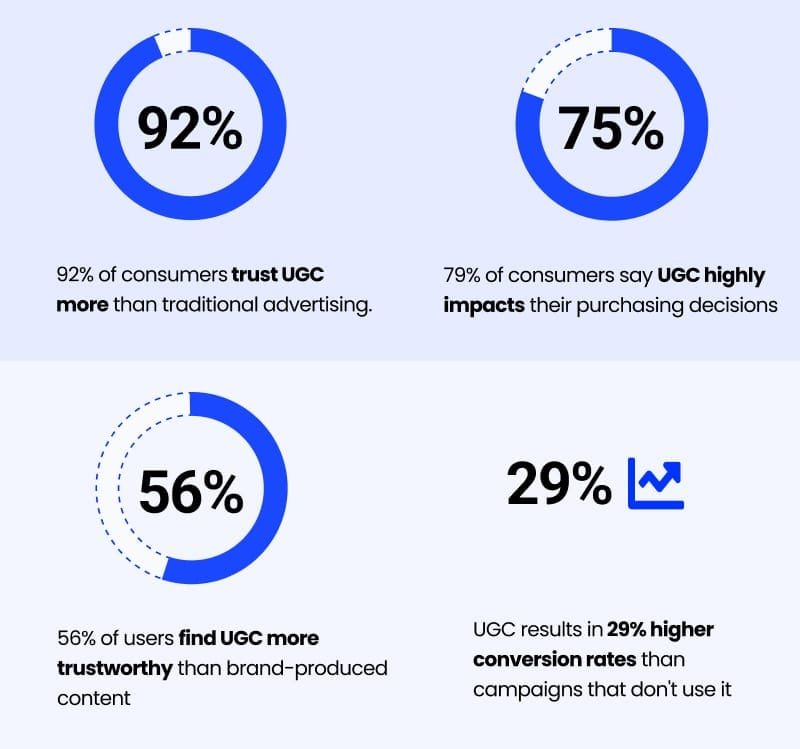(This Article has been revised, edited and added to, by Poulomi Chakraborty.)
In the vast digital expanse where brands, individuals, and organizations constantly produce content, there’s a phenomenon that’s subtly altering the dynamics of online communication: User-Generated Content (UGC). Be it a product review, a tweet mentioning a brand, or a fan-made tribute video, UGC is everywhere, often blurring the lines between official brand messages and consumer voices. As companies lean into this reservoir of authentic content, the pressing questions emerge – is UGC a game-changer for digital strategies? Or does it bring with it a Pandora’s box of challenges and pitfalls? Let’s embark on a comprehensive journey, evaluating the multifaceted world of User-Generated Content, its potentials, and its perils.
The Rise of User-Generated Content

Before dissecting UGC’s pros and cons, it’s imperative to understand its meteoric rise in the digital age.
- Democratization of Digital Tools: Today, nearly everyone with a smartphone can create content. High-quality cameras, user-friendly editing apps, and instant publication platforms empower individuals to become creators.
- Social Media Platforms: Platforms like Instagram, Facebook, Twitter, and TikTok are not just channels for communication. They’ve become arenas for showcasing creativity, opinions, and experiences, driving the UGC wave.
- The Quest for Authenticity: In an age saturated with branded messages, there’s a growing appetite for real, unfiltered experiences. UGC, stemming directly from users, resonates as genuine and authentic.
Understanding the Evolution of UGC in the Digital Ecosystem
As we delve into User-Generated Content (UGC), it’s crucial for startup founders to recognize the transformative shift it has ushered into the digital marketing landscape. The rise of UGC marks a pivotal evolution from traditional, one-way brand communication to a dynamic, interactive dialogue between brands and consumers. This transition not only democratizes content creation but also empowers consumers to shape brand narratives directly.
Leveraging UGC for Brand Authenticity and Growth
Cultivating a Community-Centric Brand Image
In the digital age, where consumer trust is as valuable as currency, startups can leverage UGC to forge a community-centric brand image. Encouraging your audience to share their experiences and stories can transform your brand from being just another entity in the market to a platform where real voices are heard and valued. This strategy not only amplifies your reach but also deepens your connection with your audience, fostering a loyal community around your brand.
Strategic Content Curation and Amplification
The effective curation and amplification of UGC can serve as a cornerstone for your digital strategy. Startups must develop a keen eye for identifying and elevating content that resonates with their core values and audience’s interests. Highlighting exceptional user content on your platforms not only rewards and motivates your community but also sets a quality benchmark, encouraging others to share their best work. This creates a self-sustaining cycle of quality content generation that can propel brand visibility and engagement.
Navigating the Challenges of UGC Integration
Establishing a Clear UGC Policy
One of the initial steps for startups incorporating UGC into their strategy is to establish a clear, transparent UGC policy. This policy should outline what type of content is encouraged, how it can be submitted, and the guidelines for usage by the brand. Providing clarity on these aspects can mitigate potential legal complications and ensure a smooth process for both the brand and its contributors.
Implementing Robust Moderation Systems
While UGC opens up a world of possibilities, it also presents the challenge of maintaining brand integrity. Startups must implement robust moderation systems to filter out content that is not in alignment with their brand values or quality standards. This involves a combination of automated tools and human judgment to efficiently manage the influx of user contributions while preserving the essence of your brand.
Utilizing UGC to Drive Innovation and Product Development
Engaging with User Feedback for Product Improvement
UGC is not just a tool for marketing but also a goldmine for insights into customer preferences and pain points. Startups should adopt a proactive approach to engaging with user feedback, using it as a springboard for innovation and product development. This not only enhances your offerings but also shows your community that their voices are instrumental in shaping the brand’s evolution.
Creating Co-Creation Opportunities
Beyond just collecting feedback, startups can elevate their UGC strategy by creating opportunities for co-creation. Inviting your community to contribute ideas for new products, features, or services can uncover unique insights and foster a deeper sense of ownership and loyalty among your users. This collaborative approach not only accelerates innovation but also strengthens the bond between your brand and its audience.
Embracing UGC as a Strategic Asset
The rise of User-Generated Content is more than just a trend; it’s a fundamental shift in the way brands and consumers interact. For startups, understanding and strategically integrating UGC into their operations can unlock unprecedented levels of engagement, authenticity, and innovation. By navigating its challenges with clear policies and robust moderation systems, and by leveraging its potentials for community building and co-creation, startups can harness the power of UGC to chart a successful path in the digital ecosystem.

1) How I Encourage Business to Generate Content For our Website
I Make it simple for customers to share their experiences through various channels like social media, website reviews, and email campaigns.
Offering incentives like discounts or free products motivates customers to contribute content, while contests and giveaways generate excitement and participation.
Once generated, I moderate UGC to ensure its quality and effectiveness, responding to feedback and highlighting positive contributions.
2) Best Practices I Follow To Optimize UGC
I advise users to include relevant keywords in their content to improve search engine visibility.
Using structured data and tags helps search engines understand the context of UGC, enhancing its SEO value.
Monitoring and moderating UGC ensures high quality, while optimizing images and videos further boosts engagement and SEO performance.
3) How I Measure The Impact Of UGC On our SEO
Tracking keyword rankings provides me insights into how our UGC affects search engine visibility.
Analyzing backlinks helps me identify the traffic generated by UGC and its impact on our SEO.
Monitoring social media engagement and website traffic reveals the reach and effectiveness of UGC strategies.
4) How I Effectively Moderate And Utilize UGC
Establishing clear guidelines for acceptable content ensures quality and relevance.
Actively monitoring and moderating UGC helps us maintain standards and address any issues promptly.
Utilizing UGC on websites, blogs, and social media platforms enhances our SEO through increased engagement and backlinks.
Prerak Mehta, Founder at NetMafia
UGC: The Unquestionable Benefits

When harnessed strategically, User-Generated Content can become a formidable asset in a brand’s digital arsenal.
Elevating Brand Loyalty Through User Engagement
The creation and sharing of User-Generated Content serve not only as a testament to a brand’s influence but also significantly enhance customer loyalty. When consumers invest time and creativity into producing content for a brand, they are more likely to develop a deeper emotional connection to the brand. For startups, encouraging UGC is akin to inviting your audience into a collaborative partnership, where their contributions are valued and celebrated. This sense of belonging can turn customers into brand ambassadors, who willingly advocate for your products or services within their networks, thereby amplifying your brand’s reach and credibility.
Enriching Market Insights With User Contributions
Beyond the surface-level engagement, UGC provides an invaluable reservoir of insights into your audience’s preferences, behaviors, and expectations. By analyzing the content created by your users, startups can gain a deeper understanding of their target market, identifying trends and patterns that can inform strategic decisions. This approach allows brands to stay ahead of the curve, adapting to shifts in consumer sentiment and market dynamics swiftly. Leveraging UGC for market research not only reduces costs but also enhances the accuracy and relevance of your findings, as it’s directly sourced from your consumer base.
Strengthening SEO and Online Visibility
The dynamic and ever-refreshing nature of User-Generated Content contributes significantly to a brand’s online visibility and search engine optimization (SEO) efforts. Search engines favor websites with fresh, relevant, and original content, and UGC can provide this at scale. Incorporating user reviews, comments, and content into your digital platforms can improve search rankings and drive organic traffic. For startups looking to establish a strong online presence, strategizing around UGC can be a cost-effective way to achieve these goals. Furthermore, featuring user content on your platforms can create a richer, more engaging web experience, encouraging longer visit durations and higher interaction rates.
Maximizing Social Proof Through Authentic Experiences
User-Generated Content is the epitome of social proof in the digital age. When prospective customers see real people sharing their positive experiences with your brand, it significantly lowers the barriers of trust and credibility. This form of endorsement is far more relatable and convincing than traditional advertising. For startups, leveraging UGC as social proof can be a game-changer in how they convert prospects into customers. Showcasing a diverse range of user experiences on your platforms not only illustrates the value of your offerings but also portrays your brand as transparent and customer-centric.
Harnessing UGC for Comprehensive Growth
In conclusion, the benefits of User-Generated Content extend far beyond mere engagement or content creation; they touch upon the very core of brand-building, customer loyalty, market research, and online optimization. For startups, embracing UGC with a strategic approach can unlock a wealth of opportunities for growth, innovation, and connection. By fostering a culture that celebrates and amplifies user contributions, startups can cultivate a vibrant community of advocates, gain rich insights into their market, and significantly enhance their digital footprint. The key lies in recognizing UGC not just as a beneficial by-product of digital interaction but as a strategic asset that, when leveraged effectively, can drive unparalleled success.

In the B2B space, UGC isn’t just important—it’s invaluable. While traditionally associated more with consumer-facing brands, UGC holds immense potential for B2B companies in building credibility, fostering trust, and driving engagement.
Our process for soliciting UGC involves strategic initiatives tailored to our B2B audience:
1. Expert Roundups: We curate expert roundups where industry thought leaders and influencers share insights, tips, and best practices. By featuring these contributions on our blog or social media channels, we not only provide valuable content to our audience but also leverage the authority and credibility of the contributors.
2. Case Studies and Success Stories: We encourage clients and partners to share their success stories and experiences with our products or services. These testimonials serve as powerful UGC, showcasing real-world results and solutions that resonate with potential customers facing similar challenges.
3. Community Engagement: We foster a sense of community among our audience by encouraging participation in discussions, forums, and user groups. By facilitating peer-to-peer interactions and knowledge sharing, we generate authentic UGC that reflects the diverse perspectives and experiences within our industry.
Hamna Amjad, Project Manager of DMR agency

In the dynamic world of SEO, User-Generated Content (UGC) isn’t just important; it’s a cornerstone for authenticity and relevance. Our platform, RankWatch thrives at the forefront of the SEO landscape, helping brands navigate through the complexities of search engine algorithms.
The power of UGC in SEO is undeniable. It enriches a website’s content and signals search engines about the brand’s engagement and relevance to real users’ queries and interests.
At RankWatch, we’ve developed a streamlined approach to harness UGC. We encourage our users to contribute content through our platform’s reviews, forums, and Q&As. This boosts our content’s diversity and improves our site’s SEO by keeping it fresh and updated.
We scale this by leveraging sophisticated content management systems that automate the moderation process, ensuring quality and relevance. To track the effectiveness of UGC, we utilize analytics to monitor engagement metrics and search engine rankings, continually refining our strategy to enhance user experience and SEO performance.
This process lets us keep a pulse on what truly matters to our audience, adapting swiftly to the ever-evolving SEO landscape.
Sahil Kakkar, CEO and Founder of RankWatch

User-generated content is an under-utilized resource in any industry. It’s no different in the medical tech world. Our potential customers are curious as to how previous customers have utilized services and their satisfaction levels.
Utilizing user-generated content can answer those questions quickly, while the customer is still considering whether they want to do business with us or not.
Often, it’ll help the customer make the decision faster rather than waiting to do more research on your business, as people are more likely to do business with you when they see other happy customers.
Daivat Dholakia, VP of Operations, Essenvia
The Potential Pitfalls of User-Generated Content

While the allure of UGC is undeniable, there are inherent challenges that brands and creators must navigate to avoid potential pitfalls.
- Quality Control Issues: Unlike curated brand content, UGC is vast and varied. This diversity can be a strength, but it also means that there’s no consistent standard of quality. A low-resolution image or a poorly written review can detract from the overall brand image.
- Misinformation and Fakes: Not all user-generated content is genuine. Fake reviews, staged content, or misleading information can tarnish a brand’s reputation and mislead potential consumers. In the worst cases, it can result in significant PR crises.
- Negative Feedback: Not all UGC is going to be positive. Handling negative feedback or criticism in the public domain requires tact and strategy. While constructive criticism can offer growth avenues, baseless negative content can unfairly harm a brand’s image.
- Copyright Concerns: UGC opens up a minefield of potential copyright issues. Who owns the content? Can a brand freely use a glowing review or an image without explicit permission from the user? Navigating these legal nuances is crucial.
Navigating the Complexity of Brand Consistency
The Challenge of Maintaining a Unified Brand Voice
One of the nuanced challenges that startups face with User-Generated Content is the difficulty of maintaining a consistent brand voice and identity. UGC is inherently diverse, reflecting the varied perspectives and creativity of your audience. While this diversity is a strength, it also poses a risk of diluting your brand’s core message and aesthetic. For startups, it’s vital to find a balance between encouraging user creativity and ensuring that the content aligns with the brand’s overarching narrative.
Strategic Approaches to Brand Consistency
To navigate this, startups should consider creating a brand guideline that includes the tone, style, and visual elements that UGC should ideally adhere to. Communicating these guidelines to your community can help steer user contributions in a direction that complements your brand identity. Additionally, curating and featuring UGC that exemplifies your brand’s ethos can set a benchmark for quality and relevance, guiding future contributions.
Addressing the Scale and Management of UGC
The Logistical Hurdles of User Content Volume
As a startup grows, so does the volume of User-Generated Content, presenting logistical challenges in terms of moderation and management. The sheer scale of UGC can overwhelm traditional content management systems, making it difficult to review, approve, and leverage user content effectively. This can lead to delays in content curation and potential missed opportunities to engage with your audience or highlight exceptional UGC.
Leveraging Technology for Efficient UGC Management
Implementing advanced content management solutions that are designed to handle large volumes of UGC is essential. These systems can automate the process of filtering and categorizing content, making it easier to identify and utilize high-quality user contributions. Additionally, investing in community management tools can facilitate more effective interaction with content creators, fostering a positive relationship between your brand and its advocates.
Ensuring Ethical Use and Respect for User Rights
The Importance of Ethical Practices in UGC Utilization
Another critical pitfall in the realm of User-Generated Content revolves around the ethical use of user contributions. Startups must navigate the complex terrain of copyright laws, user consent, and fair use policies. Missteps in this area can lead to legal challenges and damage to your brand’s reputation.
Adopting Best Practices for Content Usage
To mitigate these risks, startups should always obtain explicit permission from content creators before repurposing their contributions for commercial use. This can be facilitated through clear terms and conditions on user submissions and direct outreach for consent. Additionally, providing credit and recognition to content creators not only adheres to ethical standards but also encourages further participation from your community.
Transforming Pitfalls into Opportunities
The potential pitfalls of User-Generated Content, while significant, can be transformed into opportunities with the right strategies and tools. By maintaining brand consistency, efficiently managing content volumes, and adhering to ethical standards in content usage, startups can leverage UGC as a powerful tool for engagement, innovation, and growth. It’s about navigating the challenges with foresight and creativity, turning potential obstacles into stepping stones for building a more dynamic, authentic, and user-centric brand.

In the event staffing industry, leveraging user-generated content (UGC) plays a crucial role in building brand credibility, engaging audiences, and showcasing real experiences. At Premier Staff, we recognize the importance of UGC and actively incorporate it into our marketing strategies.
Soliciting UGC involves encouraging our clients, event attendees, and staff members to share their experiences, testimonials, and photos from events where Premier Staff was involved. This content is typically gathered through social media platforms, email campaigns, and dedicated feedback channels.
To scale our UGC efforts, we implement several strategies:
- Incentivized Participation: We incentivize clients and attendees to share their experiences by offering discounts, exclusive access, or rewards for submitting UGC.
- Consistent Engagement: We maintain ongoing communication with our audience, encouraging them to share their stories and engage with our brand regularly.
- UGC Campaigns: We run specific UGC campaigns focused on gathering content around particular themes or events, amplifying participation and relevance.
- Content Curation: We carefully curate and showcase UGC on our website, social media channels, and marketing materials, highlighting real-life experiences and testimonials.
Tracking results and optimizing the process involves:
- Performance Metrics: We track metrics such as engagement rates, click-throughs, conversions, and sentiment analysis to measure the impact of UGC on our audience.
- Feedback Analysis: We analyze feedback received from UGC to identify trends, areas of improvement, and opportunities for enhancing our services.
- A/B Testing: We conduct A/B testing on UGC campaigns to optimize content formats, messaging, and incentives for maximum participation and impact.
- Continuous Improvement: Based on insights gained, we iterate and refine our UGC strategies, ensuring they align with our brand goals and resonate with our target audience effectively.
Other startups in the event staffing industry also leverage UGC to strengthen their brand presence, foster trust, and drive engagement. Examples include showcasing behind-the-scenes moments, client testimonials, and success stories from events.
By harnessing the power of UGC strategically and consistently, startups can create authentic connections with their audience and drive business growth.
By continually refining our UGC processes and leveraging valuable insights, we are committed to delivering exceptional experiences and driving long-term success in the event staffing industry.
Daniel Meursing, CEO of Premier Staff
Strategies to Harness UGC Effectively
Given the potential challenges, how can brands ensure they’re tapping into UGC’s power without stumbling into its pitfalls?
- Clear Guidelines: If you’re encouraging UGC through campaigns or contests, establish clear guidelines. Define what’s acceptable in terms of content quality, themes, and presentation.
- Active Moderation: While UGC thrives on authenticity, active moderation ensures the content aligns with the brand’s values and quality standards. This doesn’t mean censoring negative feedback but addressing it constructively.
- Seek Permissions: Before using UGC in official campaigns or on different platforms, always seek permission from the original creators. This not only avoids potential legal entanglements but also fosters goodwill.
- Leverage Technology: AI and machine learning tools can assist in sorting, analyzing, and moderating vast volumes of UGC. Such tools can also help in identifying fake content or potential PR issues before they escalate.
Fostering a Culture of Contribution and Recognition
Encouraging Continuous User Engagement
To harness User-Generated Content effectively, startups need to cultivate an environment where users feel motivated and valued for their contributions. This involves going beyond sporadic campaigns or contests to establish ongoing initiatives that encourage regular content creation. By embedding opportunities for UGC in every aspect of your digital presence—from social media platforms to your official website—you create a seamless pathway for users to share their experiences and insights.
Celebrating and Rewarding User Contributions
Recognizing and rewarding your community for their contributions plays a critical role in sustaining engagement. This could range from featuring user content on your primary channels to offering incentives like discounts, exclusive access, or recognition in community spotlights. Such gestures not only show appreciation but also reinforce the value of contributing to your brand’s ecosystem, thereby encouraging others to participate.
Integrating UGC Across Your Digital Assets
Leveraging User Content for Comprehensive Brand Storytelling
User-Generated Content should not be siloed to a single platform or campaign; instead, it should be woven into the fabric of your brand’s storytelling across all digital assets. Integrating UGC into your website, email marketing, social media, and even product development processes can offer a more holistic and authentic brand narrative. This approach not only diversifies your content but also strengthens your brand’s credibility and relatability.
Creating a Unified UGC Strategy
Developing a cohesive strategy that outlines how UGC will be collected, curated, and displayed across your channels is essential. This strategy should align with your overall marketing goals, target audience, and brand values, ensuring that UGC contributes to your brand’s objectives. It also involves setting up processes for content moderation, legal compliance, and user engagement to manage UGC efficiently and ethically.
Leveraging Data and Analytics for Strategic Insights
Utilizing UGC for Actionable Insights
The wealth of data contained in User-Generated Content is a goldmine for startups looking to refine their strategies and offerings. Analyzing UGC can reveal patterns in user preferences, content performance, and engagement trends, providing actionable insights to inform product development, marketing strategies, and customer service improvements.
Implementing Tools for UGC Analytics
Investing in analytics tools specifically designed to assess UGC can help startups to track the effectiveness of their UGC initiatives and understand the impact on their brand. These tools can offer detailed metrics on reach, engagement, conversion, and sentiment, allowing for data-driven decisions that enhance UGC’s role in your marketing ecosystem.
Crafting a Sustainable UGC Ecosystem
In conclusion, effectively harnessing User-Generated Content requires a multifaceted approach that encourages community participation, integrates UGC across all digital platforms, and leverages analytics for continuous improvement. By fostering a culture of contribution, recognizing and rewarding users, and drawing strategic insights from user content, startups can create a vibrant and sustainable UGC ecosystem. This ecosystem not only amplifies your brand’s reach and authenticity but also cultivates a loyal community of brand advocates, driving growth and innovation.

In the fast-paced world of digital marketing, at Digital Web Solutions, we’ve recognized the gold mine that is User-Generated Content (UGC). This isn’t just another buzzword for us; it’s the heartbeat of authentic engagement.
Being deeply embedded in an industry that thrives on innovation and connection, UGC offers us a mirror to see exactly what resonates with our audience.
Yes, many startups in our sector are harnessing UGC, but what sets us apart is how we blend it with cutting-edge AI to curate content that’s not only relevant but also deeply impactful.
Here’s a slice from our playbook: we incentivize our community through contests and featured spots on our digital platforms to share their experiences with our services.
But it doesn’t stop at collection; we use AI-driven analytics to measure the engagement levels of different types of UGC, enabling us to scale our content strategy intelligently and refine it continuously for peak performance.
The beauty of this approach is seeing firsthand how our users’ authentic narratives can amplify our brand’s voice and drive tangible results, turning our community into our most valuable marketers.
Vaibhav Kakkar, CEO of Digital Web Solutions

In our industry, UGC content is very important in an era where authenticity and peer recommendations reign supreme. Harnessing the power of UGC can be a game-changer. Startups can leverage UGC to build trust, foster community engagement, and amplify their brand reach on a limited budget.
At NMG Technologies, our approach to soliciting UGC content is multifaceted. We actively encourage our clients to incentivize their customers to share their experiences through reviews, testimonials, and social media posts. Additionally, we leverage user-generated content platforms and tools to streamline the collection process. Scaling this effort involves implementing automated systems for content aggregation, moderation, and curation, allowing us to maintain quality while accommodating a growing volume of UGC.
Tracking results and optimising the process are integral components of our strategy. We utilize advanced analytics tools to measure key performance indicators such as engagement metrics, conversion rates, and brand sentiment analysis. This data-driven approach enables us to refine our UGC campaigns continuously, tailoring them to resonate with our target audience and maximize impact.
Mohit Maheshwari, Co-founder NMG Technologies

Related: Check out our free SEO suite

User-Generated Content: A Dynamic Landscape
The world of UGC is a reflection of the broader digital landscape – dynamic, evolving, and multifaceted. As new platforms emerge and user behaviors shift, the nature and impact of UGC will undoubtedly evolve.
For brands and creators, the challenge and opportunity lie in balancing the authenticity and raw appeal of UGC with strategic oversight and responsibility. When done right, User-Generated Content can be a treasure trove of insights, engagement, and brand loyalty.
Adapting to the Fluidity of Digital Trends
The landscape of User-Generated Content is as varied and evolving as the digital ecosystem itself. For startup founders, this fluidity presents both a challenge and an opportunity. The key to thriving in this dynamic environment is adaptability. As new platforms emerge and user behaviors shift, startups must remain agile, ready to pivot their UGC strategies to capitalize on new trends and technologies. Embracing innovation and staying ahead of the curve can transform the way brands interact with their audiences, making UGC not just a part of their marketing strategy but a central pillar of their brand identity.
Cultivating a Proactive Approach to UGC
Staying Ahead of Evolving Platforms
With the digital landscape constantly evolving, startups need to proactively explore and understand emerging platforms where their audiences are increasingly active. This could mean leveraging new forms of content on platforms like TikTok or Twitch that may not have been previously considered. Engaging with users on these platforms requires a nuanced understanding of the unique formats and communities they harbor. Startups that can quickly adapt to and engage with their audiences on these platforms will be better positioned to harness the power of UGC.
Leveraging Advanced Technologies
As artificial intelligence and machine learning technologies become more sophisticated, there are significant opportunities for startups to leverage these tools in managing and optimizing UGC. From content moderation to personalized user engagement, AI can help startups efficiently scale their UGC initiatives. Implementing these technologies not only streamlines operations but also provides a more tailored and engaging user experience, encouraging higher quality and more diverse UGC.
Fostering Innovation Through User Collaboration
One of the most powerful aspects of UGC is its potential to drive innovation. Startups should look beyond using UGC for marketing purposes alone and consider how it can inform product development, customer service, and business strategies. Inviting users to contribute ideas and feedback can lead to valuable insights, uncovering new opportunities for growth and improvement. This collaborative approach not only enhances the product or service offering but also deepens the users’ investment in the brand, creating a strong sense of community and loyalty.
Embracing the Future of UGC
As we look toward the future, the role of User-Generated Content in shaping brand narratives and fostering community engagement is undeniable. For startups, navigating this dynamic landscape requires a blend of adaptability, innovation, and collaboration. By staying attuned to the changing digital environment, leveraging emerging technologies, and actively involving users in the brand’s evolution, startups can unlock the full potential of UGC. This strategic approach not only enhances the brand’s relevance and appeal but also sets the stage for sustainable growth and success in the ever-evolving digital marketplace.

In the field of SaaS and e-commerce, UGC is the driving force for building trust and fostering community. It’s not just important; it’s integral. Most startups in our domain leverage UGC to various extents, recognizing its power to transform passive observers into engaged community members.
From reviews and testimonials to user-created tutorials and social media content, UGC serves as a testament to the real-world application and satisfaction derived from a product or service, making it invaluable.
The process begins with an invitation, reaching out to our customers to share their experiences. This is done through post-purchase emails, social media prompts, and incentives for sharing their stories. We make it as easy as possible for users to generate content, providing templates, hashtags, and platforms where their voices can be amplified.
As for scaling, it’s about creating a community around our brand where UGC is not just encouraged but celebrated. We use automated tools to collect and curate content, ensuring a steady stream of genuine user experiences that can be showcased across our digital footprints.
Every piece of UGC is a data point. We track engagement, conversion rates, and sentiment, using specialized tools that aggregate UGC across platforms to measure its overall impact.
This data feeds into our optimization strategies, allowing us to refine our solicitations, tailor our incentives, and ultimately, amplify the voices of our most passionate users. It’s a continuous cycle of feedback and improvement, driven by the real-world successes of our user base.
Marc Bishop, Director of WYTLABS
Influencer Marketing: Harnessing Authentic Voices or Mere Commercialization?

In a world where every social media scroll introduces us to opinions, recommendations, and glimpses into the lives of influencers, the line between genuine advocacy and paid promotion often seems blurred. Influencer marketing has burgeoned into a billion-dollar industry, where individuals with significant online followings collaborate with brands to promote products, services, or messages. But as this strategy takes center stage in digital marketing realms, it prompts a crucial question: Is influencer marketing the epitome of harnessing authentic voices, or is it slipping into the pitfalls of sheer commercialization? Let’s delve deep into this intriguing paradigm.
The Meteoric Rise of Influencer Marketing
Understanding the power and potential of influencer marketing begins with tracing its trajectory.
- Trust in Personalities Over Brands: Just as UGC leverages trust between peers, influencer marketing taps into the trust audiences place in personalities they follow and admire. An endorsement from a favorite influencer often holds more sway than a direct brand advertisement.
- Micro-Influencers & Niche Markets: While mega influencers with millions of followers grab headlines, it’s the micro-influencers (those with fewer but highly engaged followers) who’ve carved a niche. They often boast higher engagement rates and a more direct connection with their audience.
- Platforms Galore: From Instagram’s visual appeal to TikTok’s short-form video content and LinkedIn’s professional network, different platforms cater to varied influencer marketing strategies, allowing brands to target specific demographics effectively.
The Double-Edged Sword of Authenticity
Influencer marketing’s success hinges on authenticity. However, this very authenticity is under scrutiny.
- Paid Promotions vs. Genuine Advocacy: As brands pour money into influencer collaborations, discerning genuine endorsements from paid promotions becomes challenging. Transparency is paramount, and both influencers and brands are obligated to clearly mark paid content.
- Over Saturation: With an influx of influencer content, there’s a risk of audience fatigue. When every post seems like a veiled advertisement, the trust and authenticity that made influencer marketing successful could erode.
- Influencer Scandals: Influencers, like all individuals, are susceptible to controversies or missteps. Brands associated with such personalities face potential backlash, putting their reputation at stake.
Strategies for Genuine Influencer Collaborations
For brands seeking genuine influencer collaborations, a few strategies can ensure authenticity and efficacy.
- Value Alignment: Instead of merely looking at follower count, brands should assess if the influencer’s values align with theirs. Does the influencer’s content, persona, and audience resonate with the brand’s ethos?
- Long-Term Partnerships: Moving away from one-off promotions to long-term collaborations fosters authenticity. It signals to audiences that the influencer genuinely believes in the brand and isn’t just promoting it for a paycheck.
- Transparent Metrics: Both brands and influencers should prioritize transparency. Clear metrics regarding engagement rates, conversion metrics, and audience feedback can guide collaborations, ensuring they offer genuine value to audiences.

Adventure travel specialists value user-generated content, especially for Mount Kilimanjaro climbs.
User-generated material including images, videos, reviews, and comments on social media can showcase our clients’ Kilimanjaro climbs.
UGC helps potential tourists imagine similar vacations by reading first-hand accounts of fantastic experiences.
Hikers posting photos from the peak, trail stories, or service praise develops trust and credibility. Traditional advertising would not do this.
Additionally, user-generated content is a powerful social proof that influences tourist purchases. If friends, relatives, or influential people recommend our Kilimanjaro hikes, more people will book it.
User-generated content helps new and established travel companies market their products. It benefits adventure travel companies.
Tour operators, travel firms, hotels, and DMOs value user-generated content for attracting and retaining customers.
Helping people generate content brings together present and future Kilimanjaro trekkers and showcases the mountain’s magnificence.
We promote our brand through social media, hashtags, and contests. Additionally, we share our adventurous customers’ triumphs and experiences through UGC.
Michael Sawyer, Operations Director at Ultimate Kilimanjaro
The Rise and Ramifications of Chatbots in Customer Service

“Hello! How can I assist you today?” If this phrase reminds you of your last online shopping trip or a recent visit to a banking site, you’ve encountered the ubiquitous chatbot. As artificial intelligence and machine learning advance at lightning speed, chatbots have emerged as the frontline soldiers in the digital customer service realm. They promise efficiency, round-the-clock service, and instant answers. But as businesses increasingly deploy them, it’s worth examining: Are chatbots the future saviors of customer service, or do they herald a depersonalized era of customer-brand interactions?
Unpacking the Chatbot Phenomenon
To truly grasp the chatbot revolution, it’s pivotal to understand its underlying drivers.
- Instant Gratification: In the age of high-speed internet and on-demand services, consumers expect immediacy. Chatbots cater to this need, offering real-time responses without hold times or queues.
- Scalability: While human agents can handle one, maybe two, queries at a time, chatbots can simultaneously manage hundreds, allowing businesses to scale without proportionally increasing costs.
- Data Mining & Personalization: Chatbots don’t just answer queries; they collect data. Over time, this data can offer insights into customer preferences, behaviors, and pain points, allowing for more personalized interactions.
The Positive Ramifications of Chatbots
There’s no denying the transformative potential of chatbots in customer service.
- 24/7 Availability: Whether it’s a late-night shopping query or an early morning banking concern, chatbots are always available, offering brands a continuous global presence.
- Multilingual Capabilities: With the global nature of digital businesses, chatbots can seamlessly interact in multiple languages, breaking down barriers and expanding market reach.
- Consistency: Unlike human agents, chatbots are immune to bad days or moods. They offer consistent, error-free responses, ensuring a standardized level of service.
The Potential Downsides
However, as with all technological advancements, chatbots come with their set of challenges.
- Lack of Human Touch: While chatbots offer efficiency, they can’t replicate the empathy, understanding, or nuance of human interaction. In emotionally charged situations or complex queries, they might fall short.
- Privacy Concerns: Chatbots collect vast amounts of data. Without stringent security measures, there’s a risk of data breaches or misuse, leading to potential privacy concerns.
- Technical Glitches: A misconfigured or poorly designed chatbot can do more harm than good, leading to customer frustration and brand damage.
Balancing Tech with Touch
For businesses, the key lies in striking the right balance. Chatbots can handle routine queries and tasks, while human agents can step in for more nuanced interactions, offering the warmth and complexity that only humans can provide.

Our product is literally our customers, and that is why in our industry UGC is of the utmost importance and is vital to the success of any startup in our marketspace.
Because creating a bond of trust with our clientele is critical, we have many in-person discussions in which we truly get to know their journeys and stories, allowing us to create a comfort level.
In our discussion with our patients, we are able to gauge whether they would be someone who would be willing to contribute their input through video, social media, testimonials or other means.
We then monitor results through the engagement rates on our social media channels and website, allowing us to track results and assess effectiveness.
It is through building trust that we are able to acquire vital UGC and implement a strategy to showcase the human side of our business and build our customer base.
Dr. Robert Applebaum, Founder of ApplebaumMD
Concluding Thoughts: Navigating the Digital Dialogue
In wrapping up the discourse on User-Generated Content, it’s evident that UGC embodies the dynamic interplay between brands and their audiences in the digital age. Navigating this terrain requires a nuanced understanding of the opportunities and challenges it presents. Startups, in particular, stand at the cusp of harnessing UGC’s potential to foster authentic connections, drive engagement, and fuel growth. However, the journey is not without its pitfalls—issues of quality control, brand consistency, and ethical concerns loom large.
The key to successfully leveraging UGC lies in strategic, thoughtful implementation. Brands must not only encourage and curate user content but also integrate it seamlessly into their broader digital strategy, all while maintaining a vigilant stance on the legal and ethical implications. As the digital dialogue evolves, staying adaptable, responsive, and genuine in your approach will ensure that UGC remains a boon rather than a bane, propelling your brand towards deeper consumer relationships and sustained success in the digital marketplace.
READ NEXT:
- Legalities You Must Know Before Starting a Company in the US
- Current Account vs Capital Account Transactions in India: Explained!
- What are the types of Share Capital a Company in India can have?
- What are the various types of Preference Shares in Indian Companies?
- Types of Companies covered under the Companies Act, 2013?





















Comments are closed.